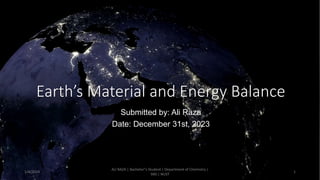CPP Assignment (ALI RAZA).pptx
- 1. Earth’s Material and Energy Balance Submitted by: Ali Raza Date: December 31st, 2023 1/4/2024 ALI RAZA | Bachelor"s Student | Department of Chemistry | SNS | NUST 1
- 3. The material balance equation for the whole Earth can be expressed as: • Accumulation=Inputs−Outputs • Accumulation: Represents the net change or accumulation of elements or compounds within Earth's reservoirs over a certain period. This includes the buildup or depletion of materials within different environmental compartments (atmosphere, hydrosphere, lithosphere, biosphere). • Inputs: Signify the influx or addition of elements or compounds into Earth's systems. This includes processes like precipitation, atmospheric deposition, volcanic emissions, biological processes, and human activities (such as industrial emissions and land-use changes). • Outputs: Denote the outflow or removal of elements or compounds from Earth's systems. This includes processes like evaporation, transpiration, erosion, absorption by living organisms, and human activities (such as combustion, deforestation, pollution). 1/4/2024 ALI RAZA | Bachelor"s Student | Department of Chemistry | SNS | NUST 3
- 4. 1/4/2024 ALI RAZA | Bachelor"s Student | Department of Chemistry | SNS | NUST 4
- 5. Earth's Energy Balance Equation: • Equation: Solar Radiation In=Thermal Radiation Out • Key Points: • Incoming Solar Radiation (Insolation): • Includes visible light, ultraviolet, and infrared radiation from the Sun. • Influenced by Earth's tilt, orbit, and atmospheric conditions. • Outgoing Thermal Radiation: • Emitted infrared radiation (heat) from Earth's surface and atmosphere into space. • Affected by greenhouse gases and atmospheric properties. • Complex Interactions: • Albedo, cloud cover, greenhouse effect, and human activities affect the energy balance. • Significance: • Crucial for understanding climate dynamics and global temperature variations. 1/4/2024 ALI RAZA | Bachelor"s Student | Department of Chemistry | SNS | NUST 5
- 6. 1/4/2024 ALI RAZA | Bachelor"s Student | Department of Chemistry | SNS | NUST 6





